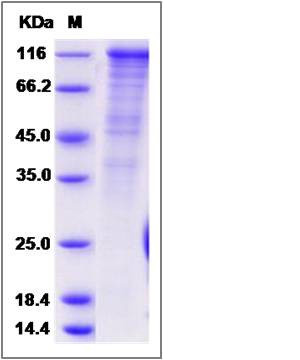Rat VE-Cadherin / CD144 / CDH5 Protein (Fc Tag)
CDH5
- 100ug (NPP2982) Please inquiry
| Catalog Number | P80276-R02H |
|---|---|
| Organism Species | Rat |
| Host | Human Cells |
| Synonyms | CDH5 |
| Molecular Weight | The recombinant rat CDH5 comprises 802 amino acids and predicts a molecular mass of 90.7 kDa. The apparent molecular mass of the recombinant protein is approximately 116 kDa in SDS-PAGE under reducing conditions due to glycosylation. |
| predicted N | Gly 25 |
| SDS-PAGE |  |
| Purity | > 75 % as determined by SDS-PAGE |
| Protein Construction | A DNA sequence encoding the rat CDH5 (NP_001100877.1) (Met1-Gln585) was expressed with a polyhistidine tag at the C-terminus. |
| Bio-activity | |
| Research Area | Cancer |Signal transduction |Cytoskeleton / ECM |Cell Adhesion |Cell Adhesion Molecules |
| Formulation | Lyophilized from sterile PBS, pH 7.4 1. Normally 5 % - 8 % trehalose, mannitol and 0.01% Tween80 are added as protectants before lyophilization. Specific concentrations are included in the hardcopy of COA. |
| Background | Cadherins (Calcium dependent adhesion molecules) are a class of transmembrane proteins. Cadherin-5, also known as VE-cadherin, CDH5 and CD144, an endothelial specific cell-cell adhesion molecule, plays a pivotal role in the formation, maturation and remodeling of the vascular wall. VE-Cadherin is widely considered to be specific for vascular endothelia in which it is either the sole or the predominant cadherin, often co-existing with N-cadherin. This specificity of VE-cadherin for vascular endothelial cells is important not only in blood and lymph vessel biology and medicine, but also for cell-type-based diagnoses, notably those of metastatic tumors. As a classical cadherin, VE-Cadherin links endothelial cells together by homophilic interactions mediated by its extracellular part and associates intracellularly with the actin cytoskeleton via catenins. Mechanisms that regulate VE-cadherin-mediated adhesion are important for the control of vascular permeability and leukocyte extravasation. In addition to its adhesive functions, VE-Cadherin regulates various cellular processes such as cell proliferation and apoptosis and modulates vascular endothelial growth factor receptor functions. Consequently, VE-cadherin is essential during embryonic angiogenesis. |
| Reference |
